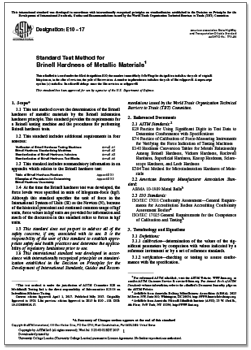英文名稱:
ASTM E10-17
Standard Test Method for Brinell Hardness of Metallic Materials
中文名稱:
ASTM E10-17
金屬材料布氏硬度標(biāo)準(zhǔn)試驗(yàn)方法
替代情況:
替代ASTM E10-15a
代號(hào)說(shuō)明:
This standard is issued under the fixed designation E10; the number immediately following the designation indicates the year of original adoption or, in the case of revision, the year of last revision.Anumber in parentheses indicates the year of last reapproval.Asuperscript epsilon (ε) indicates an editorial change since the last revision or reapproval.
This standard has been approved for use by agencies of the U.S. Department of Defense.
版本說(shuō)明:
1 This test method is under the jurisdiction of ASTM Committee E28 on Mechanical Testing and is the direct responsibility of Subcommittee E28.06 on Indentation Hardness Testing.
Current edition approved April 1, 2017. Published May 2017. Originally approved in 1924. Last previous edition approved in 2015 as E10 – 15a. DOI:10.1520/E0010-17.
2 For referenced ASTM standards, visit the ASTM website, www.astm.org, or contact ASTM Customer Service at service@astm.org. For Annual Book of ASTM Standards volume information, refer to the standard's Document Summary page on the ASTM website.
3 Available from American Bearing Manufacturers Association (ABMA), 2025 M Street, NW, Suite 800, Washington, DC 20036, http://www.americanbearings.org.
4 Available from American National Standards Institute (ANSI), 25 W. 43rd St.,4th Floor, New York, NY 10036,
標(biāo)準(zhǔn)正文:
1. Scope
1.1 This test method covers the determination of the Brinell hardness of metallic materials by the Brinell indentation hardness principle. This standard provides the requirements for a Brinell testing machine and the procedures for performing Brinell hardness tests.
1.2 This standard includes additional requirements in four annexes:
Verification of Brinell Hardness Testing Machines Annex A1
Brinell Hardness Standardizing Machines Annex A2
Standardization of Brinell Hardness Indenters Annex A3
Standardization of Brinell Hardness Test Blocks Annex A4
1.3 This standard includes nonmandatory information in an appendix which relates to the Brinell hardness test:
Table of Brinell Hardness Numbers Appendix X1
Examples of Procedures for Determining Appendix X2
Brinell Hardness Uncertainty
1.4 At the time the Brinell hardness test was developed, the force levels were specified in units of kilograms-force (kgf). Although this standard specifies the unit of force in the International System of Units (SI) as the Newton (N), because of the historical precedent and continued common usage of kgf units, force values in kgf units are provided for information and much of the discussion in this standard refers to forces in kgf units.
1.5 This standard does not purport to address all of the safety concerns, if any, associated with its use. It is the responsibility of the user of this standard to establish appropriate safety and health practices and determine the applicability of regulatory limitations prior to use.
1.6 This international standard was developed in accordance with internationally recognized principles on standardization established in the Decision on Principles for the
Development of International Standards, Guides and Recommendations issued by the World Trade Organization Technical Barriers to Trade (TBT) Committee.
2. Referenced Documents
2.1 ASTM Standards:
E29 Practice for Using Significant Digits in Test Data to Determine Conformance with Specifications
E74 Practice of Calibration of Force-Measuring Instruments for Verifying the Force Indication of Testing Machines
E140 Hardness Conversion Tables for Metals Relationship Among Brinell Hardness, Vickers Hardness, Rockwell Hardness, Superficial Hardness, Knoop Hardness, Scleroscope Hardness, and Leeb Hardness
E384 Test Method for Microindentation Hardness of Materials
2.2 American Bearings Manufacturer Association Standard:
ABMA 10-1989 Metal Balls 3
2.3 ISO Standards:
ISO/IEC 17011 Conformity Assessment—General Requirements for Accreditation Bodies Accrediting Conformity Assessment Bodies 4
ISO/IEC 17025 General Requirements for the Competence of Calibration and Testing 4
3. Terminology and Equations
3.1 Definitions:
3.1.1 calibration—determination of the values of the significant parameters by comparison with values indicated by a reference instrument or by a set of reference standards.
3.1.2 verification—checking or testing to assure conformance with the specification.
3.1.3 standardization—to bring in conformance with a known standard through verification or calibration.
3.1.4 Brinell hardness test—an indentation hardness test using a verified machine to force an indenter (tungsten carbide ball with diameter D), under specified conditions, into the surface of the material under test. The diameter of the resulting indentation d is measured after removal of the force.
3.1.5 Brinell hardness number—a number, which is proportional to the quotient obtained by dividing the test force by the curved surface area of the indentation which is assumed to be spherical and of the diameter of the ball.
3.1.6 Brinell hardness scale—a designation that identifies the specific combination of ball diameter and applied force used to perform the Brinell hardness test.
3.1.7 Brinell hardness testing machine—a Brinell hardness machine used for general testing purposes.
3.1.8 Brinell hardness standardizing machine—a Brinell hardness machine used for the standardization of Brinell hardness test blocks. The standardizing machine differs from a
regular Brinell hardness testing machine by having tighter tolerances on certain parameters.
3.1.9 force-diameter ratio—a number calculated as the ratio of the test force in kgf to the square of the indenter ball diameter in mm (see Table 1).
在線閱讀 免費(fèi)下載







